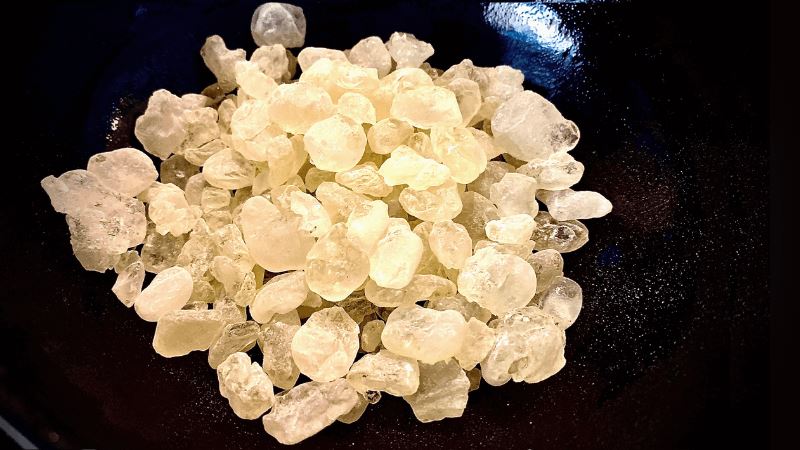What is Mastic Gum
Mastiha, or Mastic Gum as it is commonly known as is a dried sap, derived from an evergreen tree only found in Greece—the Mastic tree (Pistacia Lentiscus). The sappy “tears” that drip from the tree are an aromatic resinous material that is commonly chewed as gum to aid in digestion and improve dental health. This natural gum may be hard to come by, but it is gaining popularity in the realms of natural health and culinary and beverage experimentation. Though it is only recently gaining traction as a culinary ingredient throughout the world, many popular dishes in Greek cuisine would not exist without the tears or the mastic tree.
What Mastiha is and How to Use It
What does mastic gum taste like?
We highly recommend inhaling the sweet aroma of mastiha prior to popping a tear into your mouth as a replacement for chewing gum. The notes of citrus and pine will enliven your mind and may just give you a renewed sense of energy. Once you do place the mastic gum into your mouth, you might first believe it to be incredibly mild and underwhelming but as you begin to chew, the mastiha comes to life, releasing refreshing flavor elements reminiscent of juniper, lemon zest, and anise.
What are some dishes mastic gum is used in?
Since mastiha hails from the Greek isle of Chios in the Northern Aegean Sea, it is understandable that it is primarily found in Greek baked goods. In fact, it is a required ingredient in tsoureki, the famous Greek Easter bread and koulourakia, which are Easter cookies. It also frequently imbibed in cocktails containing Mastika, a similarly named liquor with mastic tears used for a flavoring agent.
While Easter seems to be the time this ingredient really gets its window of fame, we love the versatility of this ingredient in both sweet and savory applications. It pairs beautifully with chocolate, berries, and cheeses and will leave everybody wondering what your “secret ingredient” is. We suggest experimenting in the kitchen with this ingredient but here are a few ideas:
- Grind and mix with a little bit of orange zest and sugar to sprinkle on dark chocolate truffles.
- Use some of that same mastiha and sugar mixture to rim a cocktail glass (perfect for a gin and tonic).
- Grind with some Greek sea salt and blend it into a whipped feta spread. Serve with cucumbers, pita, or crackers.
- Mix ground mastiha with fresh chopped herbs and spices and rub it over chicken for grilling. Serve as is or simmer dried fruit in white wine with a bit of garlic for about 10 minutes. Pull the sauce and mix with a bit of olive oil, chopped green olives (we prefer Castelvetrano), salt, and fresh cracked pepper and serve over the chicken.
- Mastic gum marries beautifully to anything citrus! Add a bit to your next batch of limoncello, sprinkle it atop a fruit salad or tart, add it to a lemon sauce to serve with seafood, or mix it into a citrus pesto to serve with just about any protein.
What are the health benefits of mastiha?
Like many substances sourced of this earth, mastiha spans both culinary and medicinal realms. The list of suggested health benefits associated with these “Tears of Greece” is long, but the most evidence-based reports revolve around combatting bacteria and aiding in digestive relief, both are likely due to the high levels of antioxidants. So whether the bacteria you want to eliminate is leading to bad breath or ulcers, replacing your usual gum with mastiha might be the solution.
How do you use mastic gum in cooking?
Since mastic tears are formed of resin, they are naturally very sticky. These “tears” are typically sold in a crystal-like form and can simply be ground using a mortar and pestle. It can also be ground in a blender or spice grinder, but if you choose to use this method it is absolute necessity to freeze it first. Since mastiha is a resinous sap, those “crystals” will transform into a sticky mess when heated, which happens with the friction in both blenders and the spice grinder. Mastic gum is often mixed with salt or sugar to season food, both sweet and savory.
Where to find Mastic Gum:
Unless you live in Greece and have a lead on a mastic tree nearby, you won't likely be able to source this culinary goodie on your own. This unique ingredient isn't found in most stores, either. Your best bet is to find a reputable online source. At Slofoodgroup, we only source high-quality natural mastic tears, without any fillers or additives.







Slofoodgroup
Author